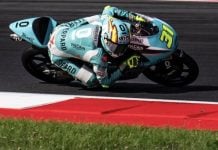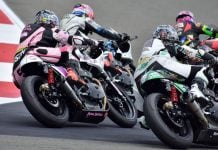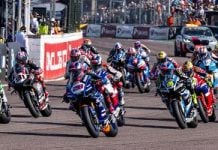BEHIND THE SCENES WITH THE NEW TIRE REGULATIONS New rules present bigger challenge, reduce tire consumption by 40% Michelin has had to totally change its modus operandi to work within MotoGP’s new tire regulations that restrict riders to 31 slick tires over each race weekend. The new rules place an even greater responsibility on the shoulders of the tire companies because they now need to cover all possible track and weather conditions within a very limited allocation of slick tires. This requires a much increased level of behind-the-scenes work. “Our job is much more difficult and much more complex now but of course that makes success taste all the sweeter,” says Jean-Philippe Weber, Michelin’s director of motorcycle racing. “The big challenge is all the theoretical work we have to do behind the scenes. We have a lot of people within our R&D center who carefully consider all the models and all the data we have to develop constructions and compounds that will suit the conditions within a very limited number of tires.” Michelin usually begin working on tire choice for each race about a month before the event, but it’s an ongoing process, final decisions on tire production can be made just a few days before the event. Some tires are therefore manufactured well in advance, others much closer to the date of the race. “We may want to use what we’ve learned from the previous race or post-race tests undertaken at the previous event in some of the tires we make,” adds Weber. “So, for example, from what we learned with Valentino Rossi (Fiat Yamaha Team YZR-M1-Michelin) during the Istanbul race we are making stronger construction rear tires for the Yamahas. And then, of course, we have to consider the weather forecasts. For example, the last tires we made for Istanbul only left the factory on the Monday before the race and for China they will be made ten days before the race. Riders and teams were involved in tire choice prior to manufacture for the Qatar and Spanish GPs because they had only recently tested at Losail and Jerez. But with no pre-event tests at Istanbul or Shanghai they must rely on Michelin’s expertise. “For Istanbul we made casings and constructions according to the direction each of our riders took during winter testing, this is part of the process of tailor-making tires for all our riders. Then we included the information we have about the track, the bikes and the weather, computed all that data together and produced each rider’s tire allocation. For Shanghai we will factor in what we learned in Turkey. While most of our Honda riders chose good tires at Istanbul, we learned that the Yamaha needs a stronger rear casing. “At Istanbul we had five different specs of rear slick for our riders to choose from and at Shanghai we will have a minimum of five specs but we will have more at some events. For example, the weather is more difficult to predict at places like Donington and Assen, so we may have a wider range of specs from which riders can choose their selection on the day before practice starts.” The permutations of different tire specs certainly aren’t endless because within the allocation of 17 slicks two or three may be qualifiers. “Most riders choose between three and five different specs of rear slicks and that’s it,” Weber explains. “If you were to choose six different specs it would be almost impossible to manage because you’d only have two tires of each spec.” Tire selections are made on the day before practice begins, when each rider’s 31 tires are barcoded. From that point on riders have to make do with the tires they’ve got. And it’s quite possible that they won’t always have the best tires for all conditions over the race weekend. At Jerez, for example, morning temperatures were much lower than forecasts had predicted. “The morning sessions at Jerez were much colder than expected, which made it quite difficult, but riders just have to deal with that. They need to understand that if they don’t have the best tire for the morning session then that doesn’t mean they need to change the whole bike set-up. So long as they know how they’re working towards the race then it’s okay, and we’re very happy with the way our teams worked towards the race at Jerez.” “Many of the riders seem to like the new rules because in a way their job is now simpler. When they had an endless supply of many different tires it could be confusing, and it was certainly very time-consuming because they had so many different tires to test. Now they know exactly what they’ve got for the weekend, so they can focus on what they’ve got and work to make the best race tire choice.” The new rules are certainly reducing the number of tires used. “This year we are making less tires and using less tires,” reveals Weber. “At Qatar (where Michelin has the same number of riders as they had last year) we used 300 less tires than we used in 2006, that’s a reduction of around 40 percent.” More, from a press release issued by Bridgestone: Bridgestone MotoGP Feature: Wet Tyre Development Shanghai plays host to the next round of the 2007 MotoGP world championship, the Chinese Grand Prix, a race in which Bridgestone-shod Kawasaki rider Olivier Jacque excelled two years ago. Jacque, making his Bridgestone debut in MotoGP that season, stormed to a sensational second place just 1.7s from race winner Valentino Rossi in the first ever Chinese GP event, which showcased the competitiveness of Bridgestone’s wet weather grooved tyres. New technical regulations have altered Bridgestone’s approach to wet tyre development since that race, as Tohru Ubukata, Manager of Bridgestone’s motorcycle race tyre development, explains: “The tyre regulations we have in place for the 2007 season stipulate that wet tyres must have a land-sea ratio of at least 20% and that the grooves must be at least three millimetres in depth. In the past, we had no tyre limitations during a GP weekend, so we were able to produce ‘cut slicks’ which are slick tyres with small hand-cut grooves for damp conditions. The 31 tyre restriction prevents us from doing this so extensively this year, so we have had to make a wider range of wet tyres to cover full wet conditions and damp-drying conditions, since the number of wet tyres is not restricted by the regulations.” The characteristics of wet tyres differ greatly to their slick counterparts, which mean that any occasions to test in rain conditions are welcomed by tyre manufacturers. “There is a big difference between the design, construction and general characteristic of a wet tyre compared to a slick,” comments Ubukata. “Wet tyres are not placed under so much stress as dry tyres because there is a slippery, protective filter of water between the track and the tyre. This also lowers the operating temperature, so we make our wet tyres softer with a greater operating window than the slicks which must always perform within tight performance confines at higher temperatures.” In order to achieve optimum performance in the slippery wet conditions, the tyres contain patterned grooves whose purpose are expressly to act as a water removal mechanism to obtain as much grip as possible from the circuit. The tyre compounds, even for wet specifications, are also adjusted to cope with the severity of the different circuits. Bridgestone also benefits from a cross-over of its Formula 1 tyre development through the use of ‘Hydro-Simulation Technology’ at its technical centre in Japan. “We developed the Hydro Simulation Technology in Formula 1 tyre development several years ago, but recently MotoGP has also benefited,” says Ubukata. “Essentially, it is a computer-based simulation which helps us to study the effects of the tyre’s contact patch on a wet track to understand how different tyre patterns work to remove the water. The pattern of the tyre is important since it is designed not only to clear water, but it also has a separate effect on the grip level provided and it affects how the compound works. The work done on Hydro Simulation enables us to make good progress before we get to the race track, making wet tests crucially more efficient and productive. There is no real correlation between wet and dry tyre testing data,” he says. “Whenever track conditions are wet, the test programme and test focus automatically shifts in order to maximise the opportunity to gain data. Wet tests are unpredictable and always useful because it is a rare occurrence that we have the chance to run in full wet conditions.” Highlighting the infrequency of wet racing, China 2005 was one of the last completely wet MotoGP races and Bridgestone’s wet tyres helped Olivier Jacque secure a strong second place for Kawasaki, the team’s best result of the season. “That was a strong performance and a real breakthrough for Bridgestone’s wet weather tyres, which helped us reach a competitive level,” says Ubukata. “Last year’s Australian GP at Phillip Island also gave us encouraging results. The weather was mixed with a dry-wet-drying track during the GP and the first time we saw riders forced to change bikes for wet tyres mid-race. Chris Vermeulen got a second place podium finish for Suzuki. When the track was fully wet, our tyres performed very well, but we could clearly see that our tyres needed more performance in the damp-drying conditions, so we have since developed a range of tyres to cope with such conditions. We recently verified the performance of these tyres in the post Jerez GP test, which gave us encouraging results. The recent wet running in the post-Jerez GP test also enabled Bridgestone to gather interesting data from the 800cc machines for the first time. “From the Jerez test in March, we were able to understand that there is not a great difference between wet tyre performance using 990cc machines and 800cc bikes. It was the first time that we were really able to carry out a proper comparison in these conditions and the results have been beneficial in further developing our latest generation of wet tyres,” concludes Ubukata.
Updated: New MotoGP Tire Rules Reduce Tire Consumption, Reduce Rider Workload But Increase Work For Tire Manufacturers
Updated: New MotoGP Tire Rules Reduce Tire Consumption, Reduce Rider Workload But Increase Work For Tire Manufacturers
© 2007, Roadracing World Publishing, Inc.






